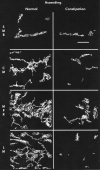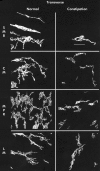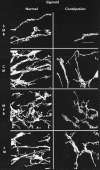Pan-colonic decrease in interstitial cells of Cajal in patients with slow transit constipation
- PMID: 12235070
- PMCID: PMC1773407
- DOI: 10.1136/gut.51.4.496
Pan-colonic decrease in interstitial cells of Cajal in patients with slow transit constipation
Abstract
Background: Interstitial cells of Cajal (ICC) are required for normal intestinal motility. ICC are found throughout the human colon and are decreased in the sigmoid colon of patients with slow transit constipation.
Aims: The aims of this study were to determine the normal distribution of ICC within the human colon and to determine if ICC are decreased throughout the colon in slow transit constipation.
Patients: The caecum, ascending, transverse, and sigmoid colons from six patients with slow transit constipation and colonic tissue from patients with resected colon cancer were used for this study.
Methods: ICC cells were identified with a polyclonal antibody to c-Kit, serial 0.5 microm sections were obtained by confocal microscopy, and three dimensional software was employed to reconstruct the entire thickness of the colonic muscularis propria and submucosa.
Results: ICC were located within both the longitudinal and circular muscle layers. Two networks of ICC were identified, one in the myenteric plexus region and another, less defined network, in the submucosal border. Caecum, ascending colon, transverse colon, and sigmoid colon displayed similar ICC volumes. ICC volume was significantly lower in the slow transit constipation patients across all colonic regions.
Conclusions: The data suggest that ICC distribution is relatively uniform throughout the human colon and that decreased ICC volume is pan-colonic in idiopathic slow transit constipation.
Figures





Comment in
-
Is constipation caused by a loss of colonic interstitial cells of Cajal?Gastroenterology. 2003 Jul;125(1):264-5; discussion 265-6. doi: 10.1016/s0016-5085(03)00829-1. Gastroenterology. 2003. PMID: 12851896 No abstract available.
References
-
- Huizinga JD, Thuneberg L, Kluppel M, et al . W/kit gene required for interstitial cells of Cajal and for intestinal pacemaker activity. Nature 1995;373:347–9. - PubMed
-
- Thomsen L, Robinson TL, Lee JC, et al. Interstitial cells of Cajal generate a rhythmic pacemaker current. Nat Med 1998;4:848–51. - PubMed
-
- Lee JC, Thuneberg L, Berezin I, et al. Generation of slow waves in membrane potential is an intrinsic property of interstitial cells of Cajal. Am J Physiol 1999;277(2 Pt 1):G409–23. - PubMed
Publication types
MeSH terms
Grants and funding
LinkOut - more resources
Full Text Sources
Medical
